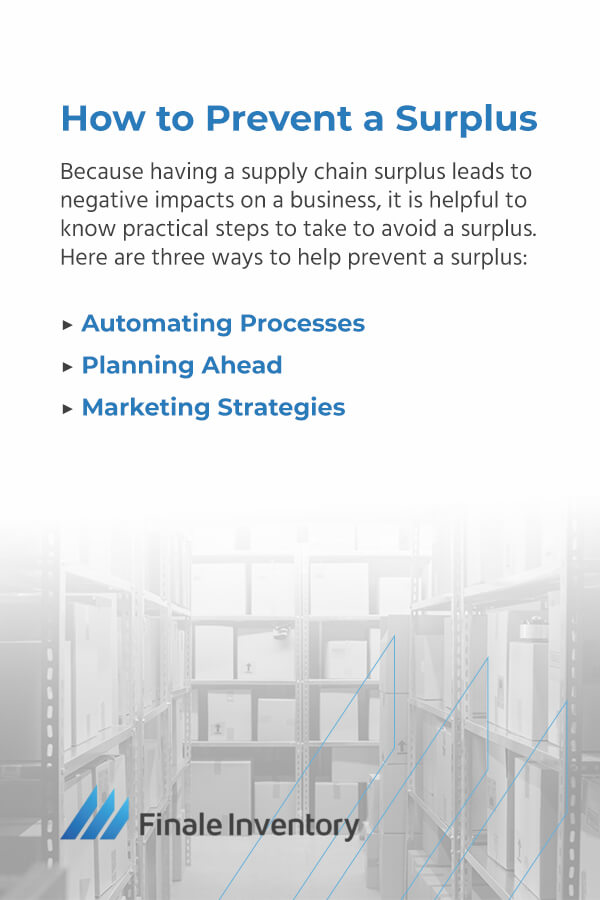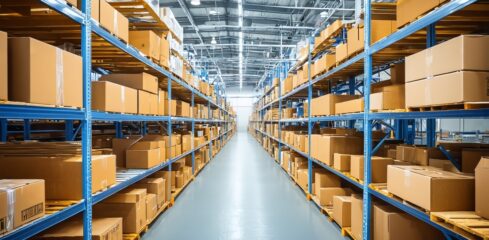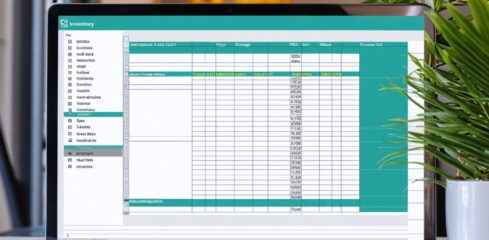

Shortages and surpluses are similar in that they disrupt the flow of a business and can cause financial troubles and a loss of customers. However, they differ in numerous ways. The causes and solutions of shortages and surpluses are very different and require businesses to look within to determine what they can do to help prevent them in the future.
Many of the causes of surpluses and shortages are completely out of a business’s control. Manufacturing interruptions, delivery issues and changes in demand are some of the potential causes that are difficult to predict. However, internal causes can be easily remedied to limit the number of shortages and surpluses a business experiences.
Causes like supply management, marketing strategies and planning are all things businesses should focus on to prevent surpluses and shortages as much as they can. Continue reading for more information about shortages and surpluses and how Finale Inventory’s scalable inventory management system can help your business thrive.
- What Is a Surplus?
- Causes of a Surplus
- Effects of a Surplus
- How to Prevent a Surplus
- What Is a Shortage?
- Causes of Shortages
- Effects of Shortages
- How to Prevent a Shortage
- The Difference Between Shortages and Surpluses
- What About Equilibrium and Disequilibrium?
- Prevent Shortages and Surpluses With Finale Inventory
- Contact Finale Inventory Today
What Is a Surplus?
An inventory surplus refers to the products in a warehouse that are taking a long time to sell or are unsellable because the relevant time has passed for the products to sell or sell for the same value. Even if stock has not lost its value when it is first considered a surplus, the longer it sits unsold, the more its value decreases, which can hurt a business financially.


Causes of a Surplus
There are several scenarios that can cause an inventory surplus:
1. Inaccurate Demand Forecasting
It is important for businesses to have a system that predicts the demand they will experience over a certain period of time based on data and trends. However, if the data is inaccurate, it can lead to a business purchasing more inventory than they need, creating a surplus.
To prevent an inaccurate demand forecast, it is important to consider all internal and external factors that could affect sales. These factors could be anything from seasonal trends to economic fluctuations.
2. Poor Inventory Management
Poor inventory management happens when a company does not have a cohesive inventory management system or team. Everyone must be on the same page to prevent a surplus. When a team is not working together, inventory tends to stay in the warehouse longer due to miscommunications and other issues. That is when a surplus occurs.
3. Supplier Constraints
To some extent, whether a surplus occurs is out of your control. You likely have to work with a supplier for at least some part of your product. Sometimes, a supplier can cause issues in your workflow that end with you having an inventory surplus.
It could be because the supplier is unreliable or they ran into an issue out of their control with the supplies they need. A supply chain has a lot of moving pieces and does not always work as seamlessly as you hope, which is why it is important to plan for all types of scenarios.
Effects of a Surplus
A surplus has negative effects on a business, as the money put toward creating the product is not returned:
1. Costs
Having a surplus hurts a business financially, as the cost of creating the product and carrying the inventory is high. When that inventory is additional, the cost goes up — usually, businesses do not own the places where they keep inventory. There is also the cost of paying employees to manage inventory, the utilities for the warehouse and other expenses.
2. Demand Variability
Customers are hard to predict, and their demand for a product could change overnight. This can quickly leave a business with a surplus on its hands. Keeping a high amount of stock automatically puts a business at risk for loss due to demand variations. That is why it is important to have a detailed system for predicting demand.
3. Negative Cash Flow
Because products lose value over time, keeping a surplus of inventory will have a negative impact on a business’s cash flow and profit. The money kept in surplus inventory is money that could be used elsewhere in a business, which adversely affects business growth.


How to Prevent a Surplus
Because having a supply chain surplus leads to negative impacts on a business, it is helpful to know practical steps to take to avoid a surplus. Here are three ways to help prevent a surplus:
1. Automating Processes
Human error is inevitable in any process. That is why automating the inventory process is the best way to ensure data is accurate. Therefore, decisions made based on that data will lead to the correct amount of inventory. Automating the inventory process minimizes errors and increases efficiency quickly so you can see clear results fast.
2. Planning Ahead
Businesses that deal with surpluses regularly often simply need to re-evaluate their planning processes. To do this, businesses should analyze their end-to-end visibility through the supply chain process using real-time analysis.
As was previously mentioned, inaccurate demand forecasting is one of the main causes of surpluses. Making changes to demand forecasting, such as automating the process, will greatly limit the amount of inaccurate demand forecasting errors that occur.
3. Marketing Strategies
Because there is no way to be accurate in a demand forecast down to the exact amount of inventory, implementing marketing strategies to make up for the difference can be helpful. If you have marketing strategies planned before you even launch a product in the event of a surplus, you will be able to seamlessly implement them when you find yourself with remaining inventory in your warehouse.
What Is a Shortage?
An inventory shortage happens when a business runs out of a product they are selling while consumers are still seeking to purchase it. Customers are hard to predict, and shortages happen when a business does not expect or appropriately plan for the amount of demand they receive for a certain product.
Causes of Shortages
There are several things that could cause an inventory shortage, including:
1. Ordering
Failing to order enough inventory is a major reason why a business would encounter an inventory shortage. This can come from inaccurate demand forecasting. However, inaccurate ordering can also occur because of an unorganized supply, which is something businesses can adjust to prevent future errors. Automating your process can help in the organization process.
2. Demand Fluctuations
Knowing what customers want is impossible to guess perfectly. Even if a business’s guess is close to accurate, demand is constantly changing. A variety of factors, such as holidays, economic conditions, trends and even the weather can affect the changes in demand. An unexpected increase in demand can leave a business with an inventory shortage.
3. Quality Control
Another cause of a shortage that is out of a business’s control is a quality control issue. If a business receives a round of inventory that has an issue caused by the manufacturer or in transit, there could be a pause in sales, as there is not enough quality inventory to sell to customers.
4. Delivery
The delivery process has a host of opportunities to be held up. Especially if the inventory is being transported from hundreds or thousands of miles away, it could encounter a number of issues that cause a delay in shipment. It is important to build in time for delays when preparing to sell a product. However, delays can extend beyond even that buffer time, leading to an inventory shortage.
5. Government Intervention
Sometimes, the government will cause a shortage if they impose a price ceiling on a product or another intervention. Doing so can cause different impacts on the supply chain, including suppliers choosing to pause or stop selling products.
Effects of Shortages
Like a surplus, a shortage has various negative impacts on a business:
1. Customer Loyalty
It is crucial to invest in customer loyalty throughout the buying process, as shortages are inevitable and can make your customers upset or disappointed. This is why it is important to give them the best overall experience — when there is some sort of hiccup, customers will be willing to work through it because of their positive feelings toward your business.
2. Reduced Profits
When a business is unable to meet customer demand, it misses out on the full profit it could’ve had with the appropriate amount of inventory. It also likely makes the time and money spent investing in a customer or on a marketing campaign an unnecessary expense.
How to Prevent a Shortage
There are several points to consider when determining how to prevent a shortage. Some overlap with the steps businesses should take to prevent surpluses, while some are unique to shortages:
1. Demand Forecasting
Once again, the importance of demand forecasting cannot be overstated. This will prevent many inaccuracies between inventory and demand. Though discrepancies are inevitable, having as few as possible will protect a business from losses due to shortages.
2. Safety Stock
For businesses to be able to prevent shortages to the best of their ability, it is important to have a safety stock. There are specific formulas to follow to calculate the amount of safety stock a business should have. Following these formulas is necessary to prevent a business from having a surplus rather than a shortage.
3. ABC Analysis
Using the ABC analysis method will help you categorize your inventory and keep it organized to know exactly how much inventory is available. The ABC analysis method organizes inventory based on importance and profitability to help break down the supply further and create the best data to forecast demand accurately.


Knowing which items in an inventory are the most valuable can help ensure there will not be a shortage with that product specifically. Though a business could still experience shortages, this sort of organization will help prevent some of them, which is beneficial to the business financially.
The Difference Between Shortages and Surpluses
Shortages and surpluses occur when supply and demand are not equal. However, there are differences between shortages and surpluses outside of their definitions. Consider the following:
Government Intervention
The government is sometimes involved in fixing both surpluses and shortages, but they have different methods to fix each one. To fix a surplus, the government will impose a price floor. A price floor implements a minimum price at which a product should be sold. If there is a shortage, the government will sometimes implement a price ceiling, which is a maximum price.
Self-Equilibrium Mechanism
Surpluses and shortages have different effects on consumers and the market. The difference is based on the market as a whole and the impact the shortage or surplus has on it.
What About Equilibrium and Disequilibrium?
A surplus causes businesses to lower their prices, which forces their competitors to do the same. In turn, the market experiences an increase in demand and moves toward price and quantity equilibrium.
A shortage will cause businesses to raise the price and quantity of a product. This may cause the business to lose some customers, but if enough are kept, the price increase will allow the business to achieve equilibrium.
Prevent Shortages and Surpluses With Finale Inventory
Finale Inventory offers a variety of services to help your business prevent surpluses and shortages as much as possible. One of the ways we do that is by helping you forecast demand accurately. Additionally, we offer comprehensive inventory management software to ensure your business can stay on top of its inventory.
Finale Inventory Demand Planning
Finale Inventory helps you plan for demand as accurately as possible. When demand planning, it is crucial to bring your staff together and make sure everyone is on the same page regarding how you are going to tackle inventory. You should have product portfolios, product forecasting and promotional plans prepared so the inventory software can have a clear picture of your business’s data.
Finale Inventory Management Software
We have strived to build an inventory management solution that smooths out even the smallest detail to make the process simple from warehousing to selling.
Our inventory management software will provide the solutions your business needs to minimize surpluses and shortages. Schedule a live demo to see how our solutions fit with your business. On top of our inventory management solutions, we offer guided onboarding, training, and support.


Contact Finale Inventory Today
If you have any questions, fill out our contact form and we will get back to you as soon as possible. We look forward to hearing from you and exploring how we can keep your business from experiencing shortages and surpluses.






